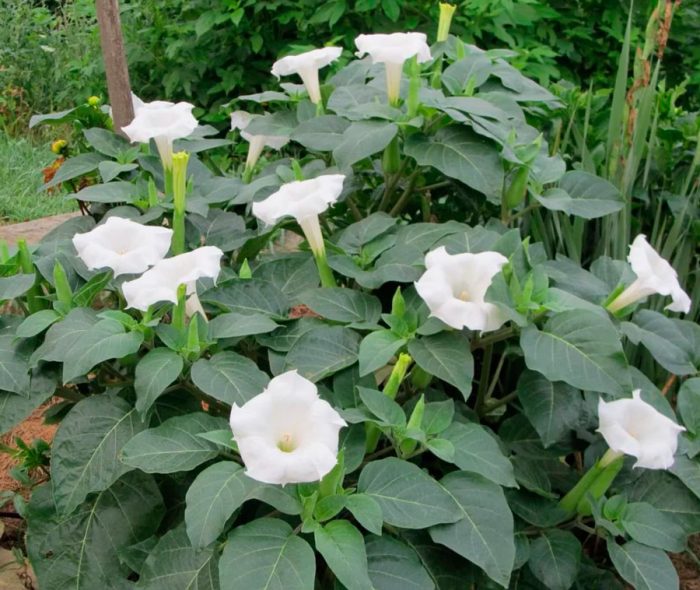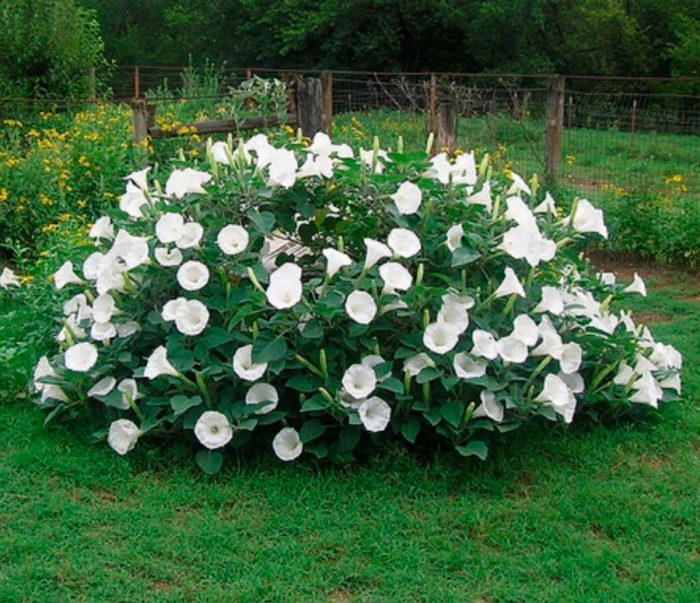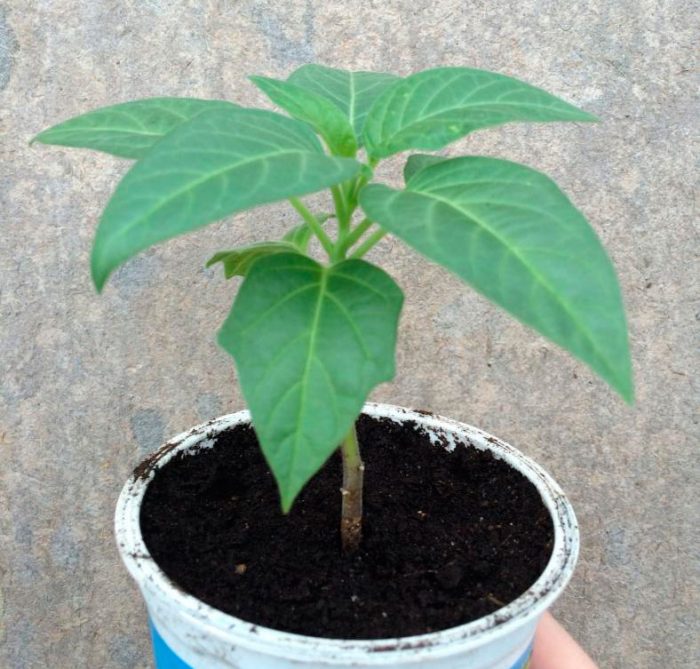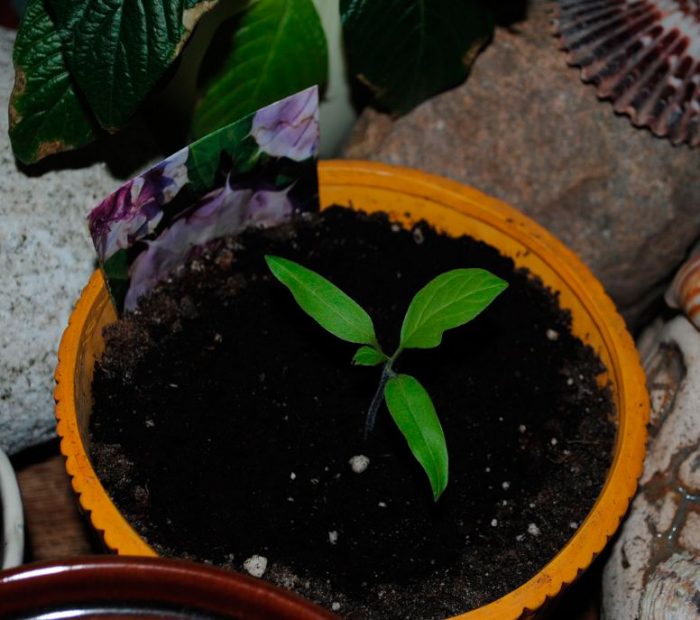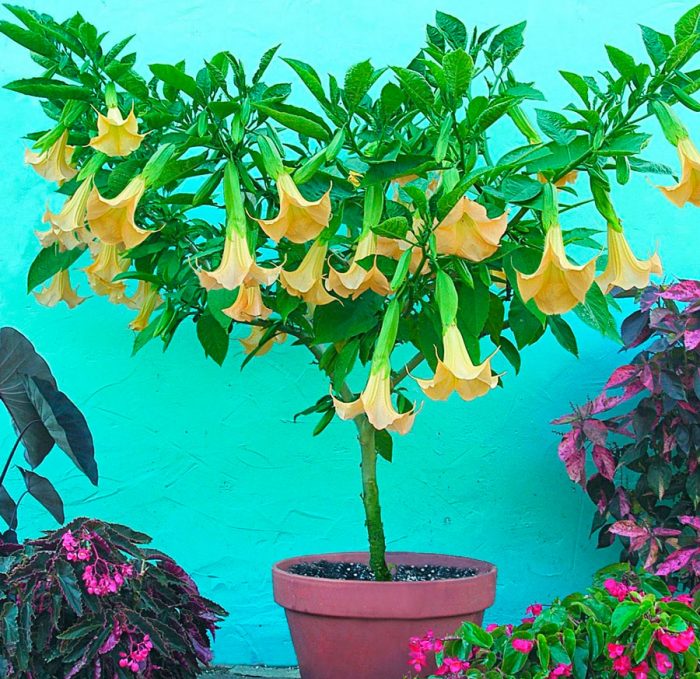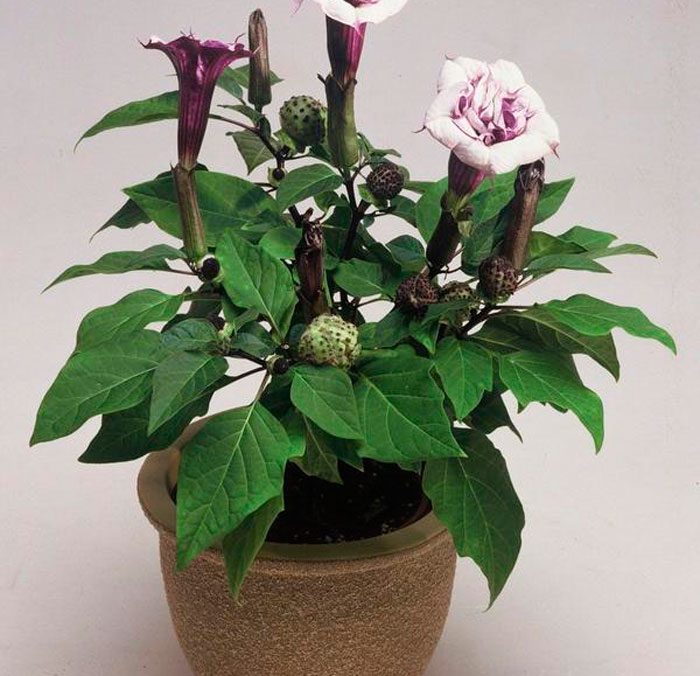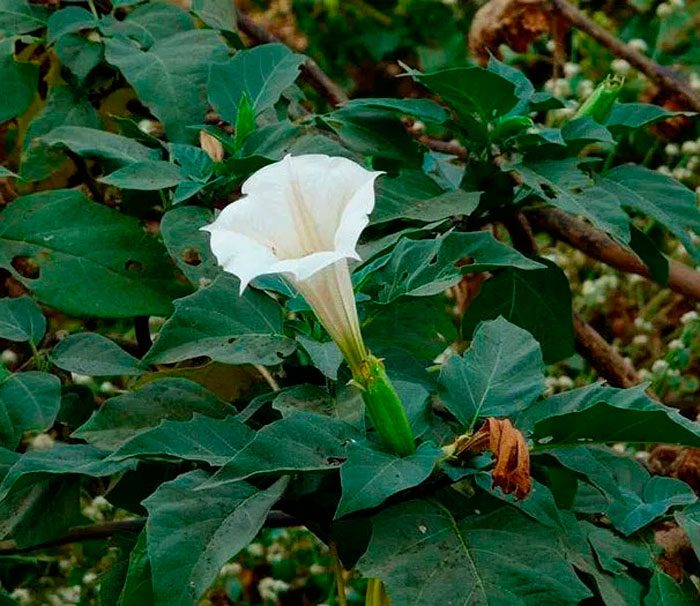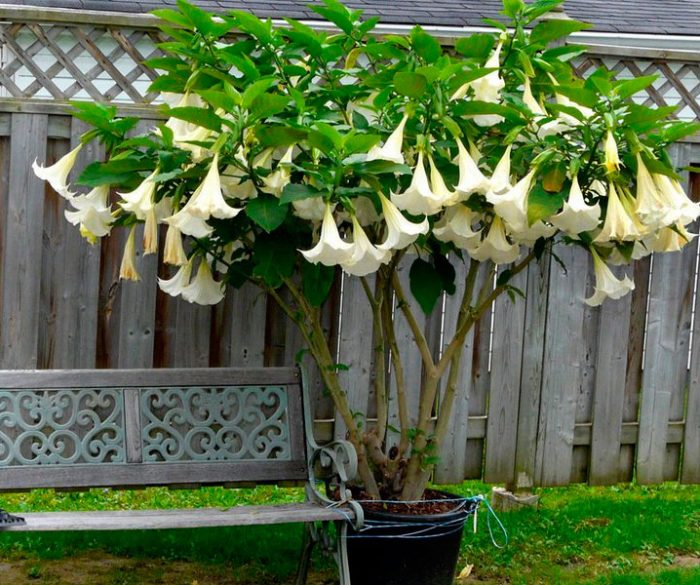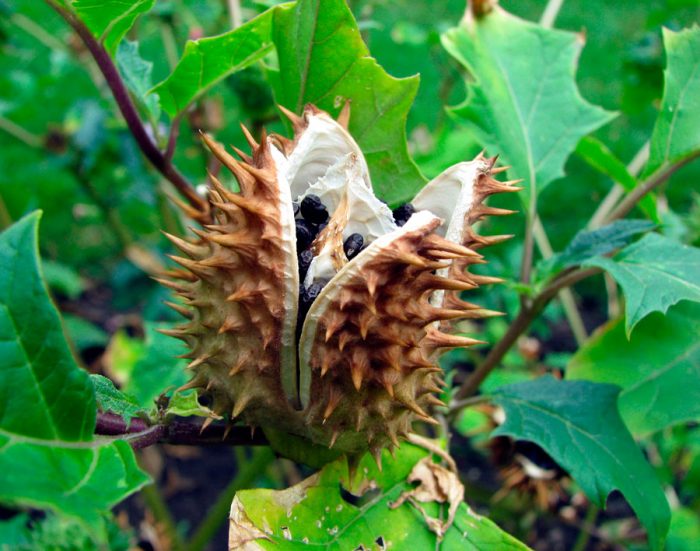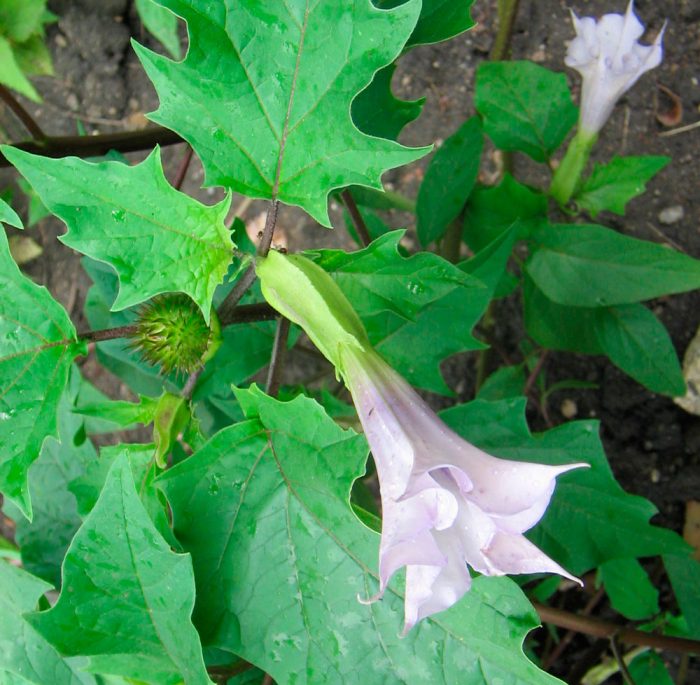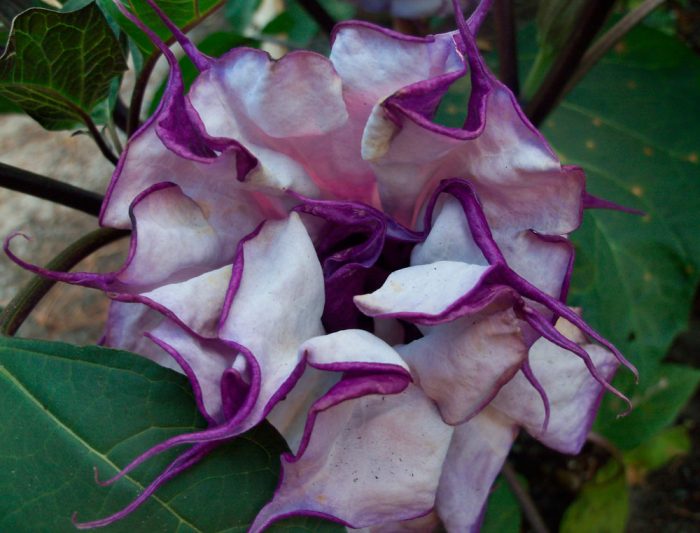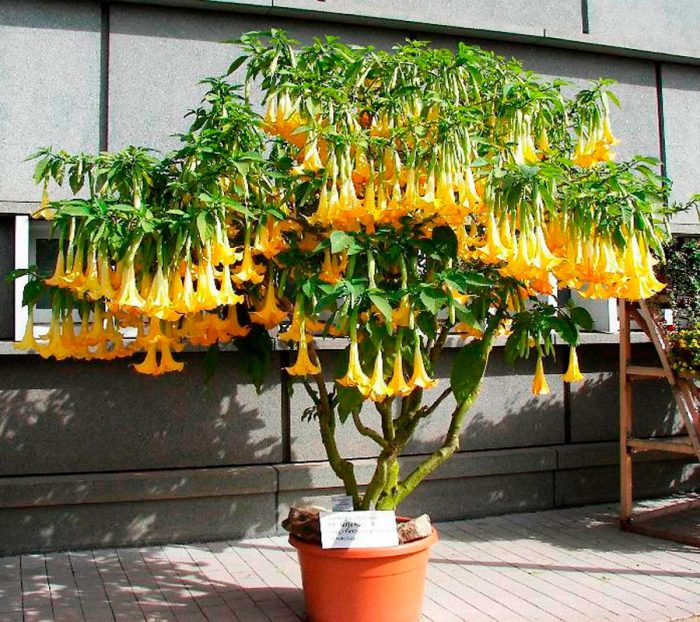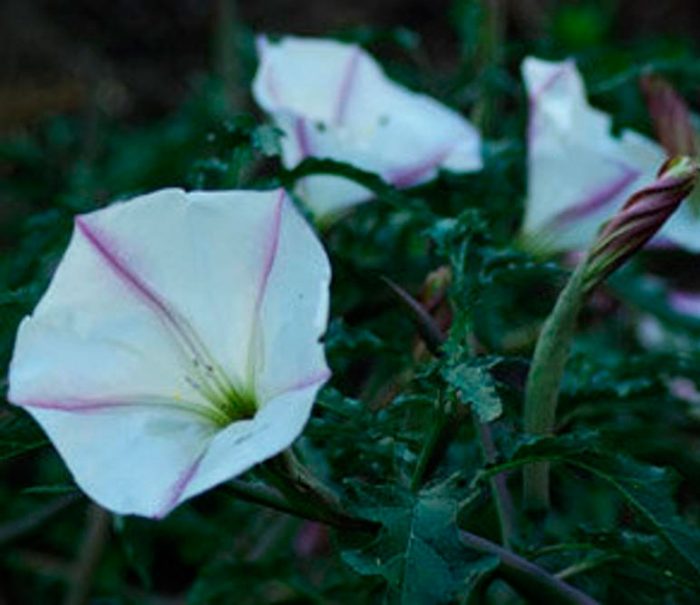The Datura plant is part of the Solanaceae family. Under natural conditions, it is found in tropical America, Mexico and Europe.
Datura is a rather large herbaceous perennial. This genus is represented by branchy low-growing trees or shrubs, they are decorated with large funnel-shaped flowers. After some time, the stem of the bush is completely lignified. Large greenish-gray foliage has an ovoid shape and reaches about 12 centimeters in length. Some varieties have a wavy edge on the foliage. Very short pubescence on the leaf surface. As a rule, if you injure the leaf plates, you can feel an unpleasant smell. In summer, the plant is decorated with large flowers, reaching about 20 centimeters in diameter, their fused petals can be painted in a red, white, yellow or pink hue. The opening of the buds occurs at night, and the lifespan of each flower is about 24 hours. During the day, the flowers remain open only if the weather is cloudy.
To date, a large number of varieties have appeared with two-color or double flowers, which look very impressive. In place of a wilted flower, a greenish fruit is formed on the bush, which is a seed capsule. Outwardly, it looks like an ovoid or round bump, the surface of which is covered with small thorns. In diameter, the fruit reaches about 50 mm. During one season, a young bush can grow up to 150-200 cm in height.
Datura bush with flowers in full bloom is a stunning sight. In some varieties, besides the fact that the flowers are very beautiful, they also have an intoxicating pleasant smell. But remember that you cannot approach a flowering plant very close, and even more so for a long time to inhale its aroma, because dope is very poisonous.
Content
Outdoor cultivation
In mid-latitudes, Datura is grown through seedlings. Only in this case, the bushes will bloom magnificently in summer.Seedlings grown in room conditions are planted in open ground only after they reach at least 15 centimeters in height. Seedlings are planted in the garden in May or in the first days of June, after the threat of return frosts is over.
When planting dope, it should be borne in mind that the bushes are fast-growing and rather large. It is because of this that a distance of at least 100 cm between them is maintained. The appearance of the first buds is observed 15–30 days after planting the bushes in open ground.
When choosing a site for planting such a crop, it should be borne in mind that it must be sunny and have good protection from strong gusts of wind. The fact is that its stems are extremely fragile, and due to strong gusts of wind, they can break. After the planting pit has been prepared, a drainage layer should be placed on its bottom; for this, you can use gravel or pieces of brick. Thanks to this, you will be able to avoid liquid stagnation in the root system.
In the open field, Datura is cultivated only as an annual, because it is not able to survive the frosty winter. However, if desired, it can be saved until next spring. To do this, in the fall, the bush is dug up, planted in a large container and brought into a heated room (you can enter the house).
Reproduction methods
Cuttings
Indoor dope can be propagated by stem cuttings, which should be half-ripe. They are harvested in spring or summer. To do this, take a disinfected, very sharp instrument and separate several cuttings with it, which should be about 10 centimeters long. Please note that the cutting must have at least 2 or 3 internodes. Tear off all the leaves at the bottom of the cuttings, thanks to this you will be able to significantly reduce the moisture loss of the cuttings. Please note that the lower cut of the segment must be oblique; for this, the cutting should be cut at an acute angle. Treat the bottom of the cutting with a root-growth agent. Plant them in the soil mixture for rooting. After the root system has formed in the cuttings, new shoots and leaves will begin to grow.
Growing from seeds
If desired, Datura can be propagated by seed. Scientists have found that the seeds of such a plant are capable of maintaining excellent germination for a long time (up to several decades).
Sowing seeds is carried out in the last winter weeks or in the first days of March. Seed material needs pre-sowing preparation, for this it is kept in water for 24 hours, the temperature of which should be from 45 to 50 degrees. Fill the seedling box with wet sand and peat soil, sow the seeds into it, and sprinkle them on top with a 5 mm layer of substrate. Transfer crops to a cool (about 16 degrees) and well-lit area that is well protected from direct sunlight. To provide the crops with uniform moisture, the top box can be covered with transparent film.
Growing Datura from seeds is easy. The emergence of the first shoots should occur 15–20 days after sowing. As soon as the seedlings appear, the film should be removed from the box. After the young plants have the first pair of true leaf plates, they are dived into separate cups. The seedlings are transferred to a warmer (from 18 to 20 degrees) place.
If you have an adult dope bush, then it is quite possible to collect seeds from it with your own hands. It is recommended to collect seed on a dry, fine day. It should be borne in mind that those seed pods that are well ripe are capable of opening themselves, while the seeds spill out onto the soil surface. In this regard, if you are planning to collect seeds, then do not forget to put on a nylon sock on the seed pods in advance.
Growing at home
How to transplant
Datura is a fast-growing plant. That is why while the bush is young, it has to be transplanted regularly, while it is recommended to increase the size of the container gradually. In the first year of growth, the bush may need several replants, because it will grow very quickly in size. Experts advise that you try to transplant the plant during the period of emergence of young leaves before the phase of intensive growth begins. If an adult dope bush is very large, then instead of transplanting it is recommended to replace the top layer of the soil mixture in the container with a new substrate.
Transplanting such a culture should be very careful, resorting to the transshipment method. The fact is that it reacts extremely painfully to trauma to the root system and recovers for a long time after that. That is why you should pull the bush out of the pot together with a lump of earth, while trying not to destroy it. A container suitable for growing datura should have large drainage holes at the bottom. The bush, taken together with a lump of earth, is placed in the middle of a new pot, and then it remains only to fill all the voids with a new soil mixture. Compact the surface of the substrate, being careful not to leave any air pockets. Water the transplanted plant with plenty of water so that the potted clod is completely wet. After a while, drain the excess liquid from the pan. After the plant is watered, the substrate can sag heavily. In this case, the required amount of soil mixture will need to be poured into the pot.
Flowering features
The flowering period of dope lasts quite a long time. It starts in March and ends in November. In order for the bush to bloom continuously and magnificently, it is necessary to remove the flowers that have begun to fade in time. If the dope grows in the garden, then its flowering ends with the onset of the first frost.
Temperature regime
In spring, summer and autumn, this culture develops normally and grows at a temperature typical for living rooms. In winter, when the dope has a dormant period, it is recommended to rearrange it in a place where the air temperature will be kept at a level of 10 to 12 degrees.
This plant is able to destroy even small frosts. When the temperature drops to 6-8 degrees, it can already get serious damage. But such a flower tolerates the heat very well, so on hot summer days it will feel quite comfortable.
Illumination
The optimal place for this flower is one that is very well lit, but at the same time protected from direct sunlight. In winter, he is at rest, and all his processes slow down. Therefore, at this time, it is recommended to rearrange the plant in a shaded cool place. However, with the onset of spring, immediately after the start of active growth, it should be transferred to its original place.
Pruning
In order for the bush to grow lush and spectacular, it is necessary to systematically pinch the tops of the shoots while the plant is young. Thanks to this, young lateral shoots will actively form in him. Pruning in time stimulates more lush flowering, because the formation of buds occurs on young shoots. When the flowering is over, the lateral shoots are greatly shortened (by 2/3 of their length).
Care features
In winter, some of the foliage can fly around the dope, but in the spring it will grow back. In the spring and summer, it is recommended to move the bush to fresh air. In this case, you should choose a place for him that will be protected from precipitation, strong gusts of wind and the scorching direct rays of the sun. It is highly discouraged to place the plant in places where it can easily be touched (corridor, passage, etc.). The fact is that even from a light touch, shoots or foliage can be injured.But the most important thing is that dope juice contains the strongest poison! To protect a tall bush from injury, it is recommended to tie it to a support.
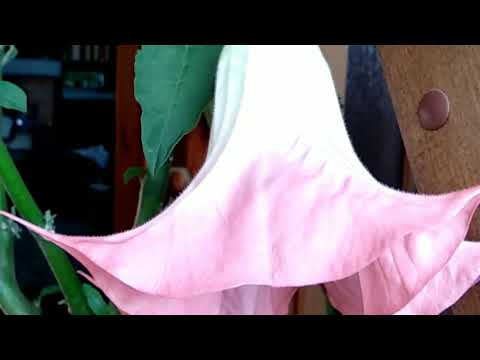

Watch this video on YouTube
Suitable soil
A soil mixture suitable for growing dope should be loose, fertile and allow water and air to pass through well. Its pH can be slightly alkaline or neutral. You can add a little lime or wood ash to the soil mixture, which will also be an excellent fertilizer for the plant.
Top dressing
The plant needs fertilization during the growing season, and feeding is carried out 1 time in 7 days. Since it is a fast growing plant, it needs a lot of nutrients. In the spring, it is recommended to feed the bush with fertilizers with a high nitrogen content. But in late spring or early summer, phosphate fertilizers begin to be applied to the soil mixture, thanks to which the flowering of dope will be lush and long-lasting.
Before adding a nutrient solution to the soil, the flower should be well watered with clean water. Otherwise, burns may occur on the roots. To feed the dope, you can use both organic matter and complex mineral fertilizer. In winter, the bush is not fertilized. They begin to feed him again only after, with the onset of spring, new shoots and leaves begin to grow.
Watering
Make sure that the soil mixture is always slightly damp. However, during a cool winter, dope is watered less frequently and less abundantly. Remember that stagnant liquid in the substrate during the cold season can cause rot. However, overdrying an earthen coma should also not be allowed. Particular attention should be paid to watering during periods of intensive growth and flowering. During this time, watering should be regular and fairly abundant.
The water temperature for irrigation should be close to room temperature. The flower can be watered with tap water, while no additional cleaning or settling is required. Many growers are sure that, thanks to hard water irrigation, the bush blooms more luxuriantly.
With a cool winter, the bush is rarely watered, preventing the complete drying out of the clod of earth in the pot. The fact that it needs to be watered will be signaled by slightly drooping leaves.
Air humidity
The bush needs regular humidification from a sprayer, and water is used at room temperature. Moisturize it in the morning, because if the moisture does not have time to evaporate from the foliage until the night, this can cause the plant to rot. When spraying a bush, make sure that no water gets on the buds and petals.
To increase the humidity of the air, moistened sphagnum can be laid around the pot. You can also put a working humidifier in the room where the flower is. And you can also put several plants next to each other, in this case they themselves will increase the level of humidity.
With a cool winter, the air humidity should be low, otherwise it can lead to the development of fungal diseases and rotting.
Please note that the room where the bush is located should be systematically ventilated, while protecting it from cold drafts. Do not put the bush near the air conditioner in summer and near an open window in winter.
Possible problems
As a result of improper care or from inappropriate growing conditions with indoor dope, the following problems can arise:
- Falling foliage... This may be due to the fact that the bush was exposed to a cold draft or a sharp change in air temperature.
- Leaf plates become flaccid and lose turgor... This happens if the air in the room is too dry, as well as due to rare or poor watering.
- The buds fall, not having time to open... The plant experiences an acute lack of moisture.
- The stems are exposed as a result of the fall of the lower foliage... This is due to the fact that the bush is not pruned. After a while, it can completely lose its decorative effect.
- The bush has weakened and its stems have become elongated... This is observed if the plant is kept in a warm room in winter, but it does not have enough light. The fact is that if the bush is not transferred to a cool place, then its dormant period will not begin, and it will continue to grow actively. But in this case, too poor lighting has an extremely negative effect on the appearance of the flower.
- The appearance of gray rot. This fungal disease begins to develop only if the bush is kept cool with high humidity. In the affected plant, a fluffy bloom of gray color is formed on the surface of the shoots and foliage.
- The buds are formed, but not blooming. The bush suffers from an acute lack of nutrients and lacks the strength to bloom.
Pests
Datura has a fairly high resistance to pests. However, sometimes red spider mites and whiteflies can still settle on it. Open field shrubs can be damaged by wireworms.
When whiteflies appear on the plant, small dots of light color can be found on the surface of its foliage. Over time, the leaves turn yellow and die off. If the bush is slightly shaken, then you can see how small white butterflies take off from it. To exterminate them, you can spray the flower with a solution of the appropriate toxic chemical: Rovikurta, Fufanol, Aktellik, Confidor, Tanrek, Zeta, INTA-VIR, Karbofos, Aktara or Commander. Also in the fight against such "intruders" you can use folk remedies: sticky traps (effective only against adults), soap solution, infusion of garlic, dandelion, as well as tobacco and yarrow.
If a red spider mite settles on the dope, then a thin cobweb can be seen on its foliage. If there are a lot of pests, then the foliage begins to actively turn yellow and fly around. Dying off of the affected foliage is observed, while small cracks form on its surface. The bush begins to grow and develop more slowly. To get rid of ticks, you can use a proven folk method. To begin with, the dope is given a warm shower, and its foliage is washed very well. Then it is left for 30 minutes in a place with very high air humidity (for example, in a bathroom). It is also recommended to irradiate the bush with an ultraviolet lamp for a couple of minutes regularly once a week. To process a flower, you can use such pesticides that are made on the basis of pyrethrum, and Fitoverm, sulfur powder and Actellik are also suitable.
Due to the wireworm, the development of the bush becomes slower, and it begins to wilt. To save him, you need to sprinkle the surface of the soil with dolomite flour, water the bush with a solution of lime, cover the ground with onion husks, and you can also use an infusion of celandine. As a preventive measure, before sowing seeds, they are powdered with wood ash. If folk remedies turned out to be ineffective, then pesticides such as Actellik, Pochin and Decis can be used for processing.
Decorativeness
Datura is a very beautiful, but rather large plant. Therefore, it is used to decorate spacious rooms. This culture is unpretentious and also blooms profusely with large graceful flowers. She is also able to decorate any garden plot with herself. If you are going to grow dope in the garden, then keep in mind that all other crops die next to it, and even weed grows extremely rarely.
Please note that if any part of such a plant enters the human body, this will lead to the development of a very strong poisoning. As a rule, a poisoned person has vivid hallucinations. It is because of this that the sorcerers of European countries used dope for various rituals.In India, the cult of dope is most widespread. It was used for ritual rituals by adherents of the cult of Kali (the goddess of death), as well as followers of Shaivism.
Often, flower growers prepare an infusion from the foliage of dope, which helps to get rid of cabbage moths and spider mites on home plants.
How is Datura useful?
Datura is a medicinal herb widely used in medicine as a pain reliever. For the first time, the Aztecs discovered this feature in this plant, and it was they who began to widely use its juice to treat wounds. Datura juice was used to carry out massive magical rituals, it helped people quickly enter a trance state.
In China, this plant was used as an antipyretic and for the treatment of diseases of the nervous system. The seeds of this flower in India were added to low alcohol drinks as an aphrodisiac and to treat male impotence. Sorcerers and witches of European countries also used such a plant in their magical rites.
Today, dope is used by official medicine as a narcotic and analgesic agent. It is used to treat asthma, cholecystitis, tachycardia, nervous disorders, peptic ulcer of the digestive tract, colitis and rheumatism. And it is also widely used in the treatment of tonsillitis and for the relief of epileptic seizures.
Datura toxicity
The poison is part of any part of the dope. The poisoned person has hallucinations, intense thirst and fever. As for the mucous membranes, they dry out and turn blue. Datura juice has the ability to cause paralysis of the respiratory center, which can lead to death.
Use extreme care when handling Datura and keep it away from pets and children. Do not forget to protect your hands with gloves when working with the flower, and then wash them thoroughly with soap and water.
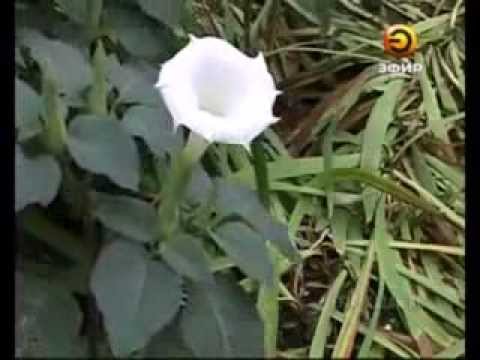

Watch this video on YouTube
Types of dope with photo
Datura ordinary, or smelly (Datura stramonium)
This vigorous herbaceous annual can have a height of 0.6 to 1.5 m. The highly branching erect stem is thick and strong. The length of the green foliage with a jagged edge is about 20 centimeters. If you injure her, you can smell an unpleasant smell. The front surface of the leaves is dark green, and the back is greenish. The petals of the funnel-shaped showy flowers are fused, they reach about 7 centimeters in diameter. Their disclosure takes place at night. They can be dyed cream, white and purple. At the end of flowering, small oval fruits are formed, reaching 30–80 mm in diameter. Their surface is covered with a large number of pointed spines.
Datura Indian (Datura metel)
This species is represented by both perennials and annuals (depending on climatic conditions). The height of the bush is about 0.9 m. On the surface of highly branched powerful stems, there is often a short pubescence. The length of the shiny dark green leaf plates is about 20 centimeters, there are large denticles on the edge, and their surface is decorated with a network of veins of a lighter shade. Double or simple single flowers bloom in the dark and have a pleasant smell, they reach 15–20 centimeters across and can be colored yellow, dark purple, white, lilac or pink. The seamy surface of the petals is shortly pubescent.
Datura tree, or brugmansia (Brugmansia)
This species is represented by a curly liana, which has very long shoots. Oblong-oval alternate leaf plates have a dark green color. In some varieties, the edge of the foliage is jagged and there is pubescence on it, represented by thin hairs. Buds are formed in the summer at the tops of the branches.Often, tubular flowers are solitary, they are colored pink, white or yellow, and reach about 25 centimeters in length. The harsh aroma of flowers can have citrus notes. In the dark, it becomes stronger and fills the entire room. This variety has drooping flowers, there are variegated forms.
Datura strong-bore (Datura ceratocaula)
The height of a vigorous annual is about 100 cm. Smooth thick branched stems are green and hollow inside. Alternately spaced oblong-lanceolate green leaf plates on the edge have large teeth, their seamy surface is shortly pubescent. Fragrant funnel-shaped flowers reach 15–20 centimeters across, they have a purple, white or pale yellow color. The bush blooms in early summer, and fades in the second half of autumn. The fruit is a smooth pear-shaped seed capsule.

